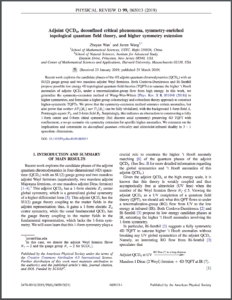
Journal of Mathematical Physics 60, 052301 (2019); https://doi.org/10.1063/1.5082852

Title: A new SU(2) anomaly Abstract: A familiar anomaly affects SU(2) gauge theory in four dimensions: a theory with an odd number of fermion multiplets in the spin 1/2 representation of the gauge group, and more generally in representations of spin 2r + 1/2, is inconsistent. We describe here a more subtle anomaly that can affect SU(2) gauge theory in four dimensions under the condition that fermions transform with half-integer spin under SU(2) and bosons transform with integer spin. Such a theory, formulated in a way that requires no choice of spin structure, and with an odd number of fermion multiplets in representations of spin 4r + 3/2, is inconsistent. The theory is consistent if one picks a spin or spinc structure. Under Higgsing to U(1), the new SU(2) anomaly reduces to a known anomaly of “all-fermion electrodynamics.” Like that theory, an SU(2) theory with an odd number of fermion multiplets in representations of spin 4r + 3/2 can provide a boundary state for a five-dimensional gapped theory whose partition function on a closed five-manifold Y is (−1)∫Yw2w3(−1)∫Yw2w3. All statements have analogs with SU(2) replaced by Sp(2N). There is also an analog in five dimensions.
PHYS. REV. D 99, 065013

Abstract: Recent work explores the candidate phases of the 4D adjoint quantum chromodynamics (QCD4) with an SU(2) gauge group and two massless adjoint Weyl fermions. Both Cordova-Dumitrescu and Bi-Senthil propose possible low energy 4D topological quantum field theories (TQFTs) to saturate the higher ‘t Hooft anomalies of adjoint QCD4 under a renormalization-group flow from high energy. In this work, we generalize the symmetry-extension method of Wang-Wen-Witten [Phys. Rev. X 8, 031048 (2018)] to higher symmetries, and formulate a higher group cohomology and cobordism theory approach to construct higher-symmetric TQFTs. We prove that the symmetry-extension method saturates certain anomalies, but also prove that neitherAP2(B2)norP2(B2) can be fully trivialized, with the background 1-form field A, Pontryagin square P2, and 2-form field B2. Surprisingly, this indicates an obstruction to constructing a fully 1-form center and 0-form chiral symmetry (full discrete axial symmetry) preserving 4D TQFT with confinement, a no-go scenario via symmetry extension for specific higher anomalies. We comment on the implications and constraints on deconfined quantum criticality and ultraviolet-infrared duality in 3+1 spacetime dimensions.
PHYS. REV. D 99, 111501(R) – PUBLISHED 10 JUNE 2019

Title: Solution to the 1+1 dimensional gauged chiral fermion problem
Abstract: We show that the 3450 U(1) chiral fermion theory can appear as the low energy effective field theory of a 1+1D local lattice model of fermions, with an on-site U(1) symmetry and finite-range interactions. The on-site U(1) symmetry means that the U(1) symmetry can be gauged (gaugeable for both background probe and dynamical fields), which leads to a nonperturbative definition of chiral gauge theory -a chiral fermion theory coupled to U(1) gauge theory. Our construction can be generalized to regularize any U(1)-anomaly-free 1+1D gauged chiral fermion theory with a zero chiral central charge (thus no gravitational anomaly) by a lattice, thanks to the recently proven “Poincaré dual” equivalence between the U(1) ‘t Hooft anomaly-free condition and the U(1) symmetric interaction gapping rule, via a bosonization-fermionization technique.
